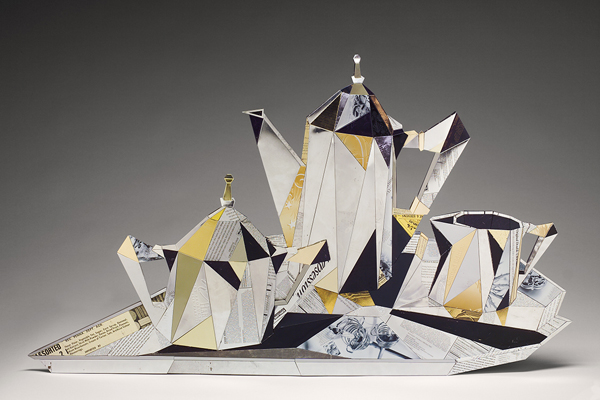California Dream and Obverse Obsession are from a series of sculptures based on a historical teapot, coffeepot, or chocolate pot. My 21st century counterparts use recycled tin cans as the foundation for construction and social commentary. Each object is larger than the original historical inspiration to reflect the super-sized, grandé, bonus-value mentality of modern America where more is better, even if you never wanted that much in the first place.
Click on the images for larger images and a complete description.
In the short presentations below I explain the design inspiration and social commentary for each object.
ARTIST STATEMENT
This Cubist Coffee Service from 2004 is a bas-relief construction of the famous photograph for Cubic Coffee Service originally titled, Lights and Shadows of Manhattan. (Currently owned by RISD museum.)
Since photographic reproductions of this famous coffee set always show the same side, my work comments on the situation in which the photographic image is more famous than the actual object. The other side of the set is never shown, and even display like the iconic photograph.
In fact, in 2004 when I saw this sterling silver set in an exhibition, its familiar, photographic front was the only side shown to the public, while the backside was not possible to view.
Like a stage set, my Cubist Coffee Service has every appearance of being the actual, three-dimensional reincarnation from a distance. In reality, it is completely flat, like a photograph. The different colors of metallic tin cans along with text were used to convey the shadow, facets, reflections and dimensions of the original object.
The original Cubic Coffee Service was a sterling silver construction. In my iteration the precious material of sterling silver plays a supporting role, literally, as the easel stand on the back.
This work asks us to re-evaluate how an object is valued in our material culture. Does value exist by how something is made; by who made it; by what materials are used; or is value created by marketing and consumption?
What does it mean to own a sterling silver coffee service in the 20th century?
HISTORICAL BACKGROUND
Lights and Shadows of Manhattan , the original sterling silver coffee service designed by Eric Magnussen for Gorham in 1927, was a significant departure for both the designer and manufacturer. As a purely modernist form it was designed and constructed as a tour-de-force response to contemporary art trends (Cubism), design trends (Art Deco) and architectural influences (skyscrapers). Although sharply criticized when first exhibited in New York, it has since become an iconic object included in almost every book related to Art Deco and 20th century design.
Materials description for Cubist Coffee Service: Coffeepot, sugar, creamer and tray constructed with steel from recycled tin cans, 10k gold, aluminum rivets, brass and stainless steel screws. Supporting easel (attached to the back) constructed from sterling silver with brass screws, feet dipped in plastic coating.
27"H x 46"W (at widest part of the tray) x 10" depth when easel is open
Cubism: Cornell and Berman is an article written by Allie Farlowe about the original silver coffeeset and tray by Eric Magnussen.
Permanent Collection of the Kamm Teapot Foundation
Below are a series of chocolate cups, chocolate pots, teapots, and coffeepots that I have made from recycled tin cans. I see the use of post consumer packaging as a reflection of our consumer society. The color, patterns and words reveal the values of our culture in a remarkably similar way to the use of sterling silver in the 18th century.












